Welcome and Opening Remarks
Welcome and Opening Remarks

Welcome and Opening Remarks
With the NVMe/TCP and disaggregated storage gaining rapid market adoption, it is more clear than ever that Storage Initiator (SI) needs to be more performant and efficient to provide applications with DAS (Direct Attached Storage) like performance and latency. At the same time, there is a growing need from virtualized applications for secure transport and storage performance near bare metal. The Host CPU can save a significant number of cycles by offloading the NVMe/TCP to a DPU based Storage Initiator (SI).
Samsung recently contributed Poseidon project, which is an OCP-based industry collaboration between component vendor (Samsung), system vendor(Inspur) and data center. Poseidon is an open-source storage software and hardware platform for NVMe-oF based systems. It's an EDSFF based storage reference system, targeted for performance and density, suitable for cloud data center. Today cloud service providers (CSP) are constantly challenged with large volumes of data and increasing demand from customers for cost effective storage.
Apache Ozone is a highly scalable distributed object storage system and also provides the file system interface. Distributed storage systems typically use replication to provide high reliability and Ozone supports the replication model for the same. However replication is expensive in terms of storage space and other resources ( ex: network bandwidth etc). Erasure Coding(EC) is a proven technique to save storage space and throughput requirements. Apache Ozone implemented the EC support.
DCE/RPC is a popular library for sending RPC calls to Active Directory from Linux/Unix systems. So far, DCE/RPC calls to Active Directory are synchronous and they actually wait for the response from Active Directory. Till that time, a thread inside DCE/RPC keeps on waiting until the response is received. This mechanism for send/receive fails and causes stuck calls in case of network disruptions, slow network, or rather flaky connections. It is required to have a solution that obviates such unnecessary hangs and handles connection issues more gracefully.
Data persistence on CXL is an essential enabler toward the goal of instant-on processing. DRAM class performance combined with non-volatility on CXL enables a new class of computing architectures that can exploit these features and solve real-world bottlenecks for system performance, data reliability, and recovery from power failures. New authentication methods also enhance the security of server data in a world of cyberattacks.
The SNIA Technical Council (https://www.snia.org/tc) would like to invite SDC attendees to a Town Hall so that they can hear from you and to discuss important upcoming storage technologies. Please join us in Salon IV for refreshments and great discussion!
In this session I will start with identifying the current problems in Artificial Intelligence as data exists in most industries/edge in the form of isolated pockets with privacy constraints for sharing the data for training an AI model. While transferring data from edge storage to a centralized cloud for training -many problems arise. Performance issues, cost and security or regulatory compliance are some of them. I’ll then walk through detailed features of federated learning combined with Blockchain to solve the above mentioned problems .
With more and more fast devices (especially persistent memory, aka. PMEM) equipped in data center, there is great pressure on CPU to drive those devices (e.g., Intel Optane DC persistent memory) for persistency purpose under heavy workloads. Because there is no DMA related capability provided by persistent memory compared with those hdds and SSD, thus CPU needs to participate the data operations on the persistent memory all the time. In this talk, we would like to mitigate the CPU pressure via hardware based memory offloading devices (e.g., Intel's IOAT and DSA).